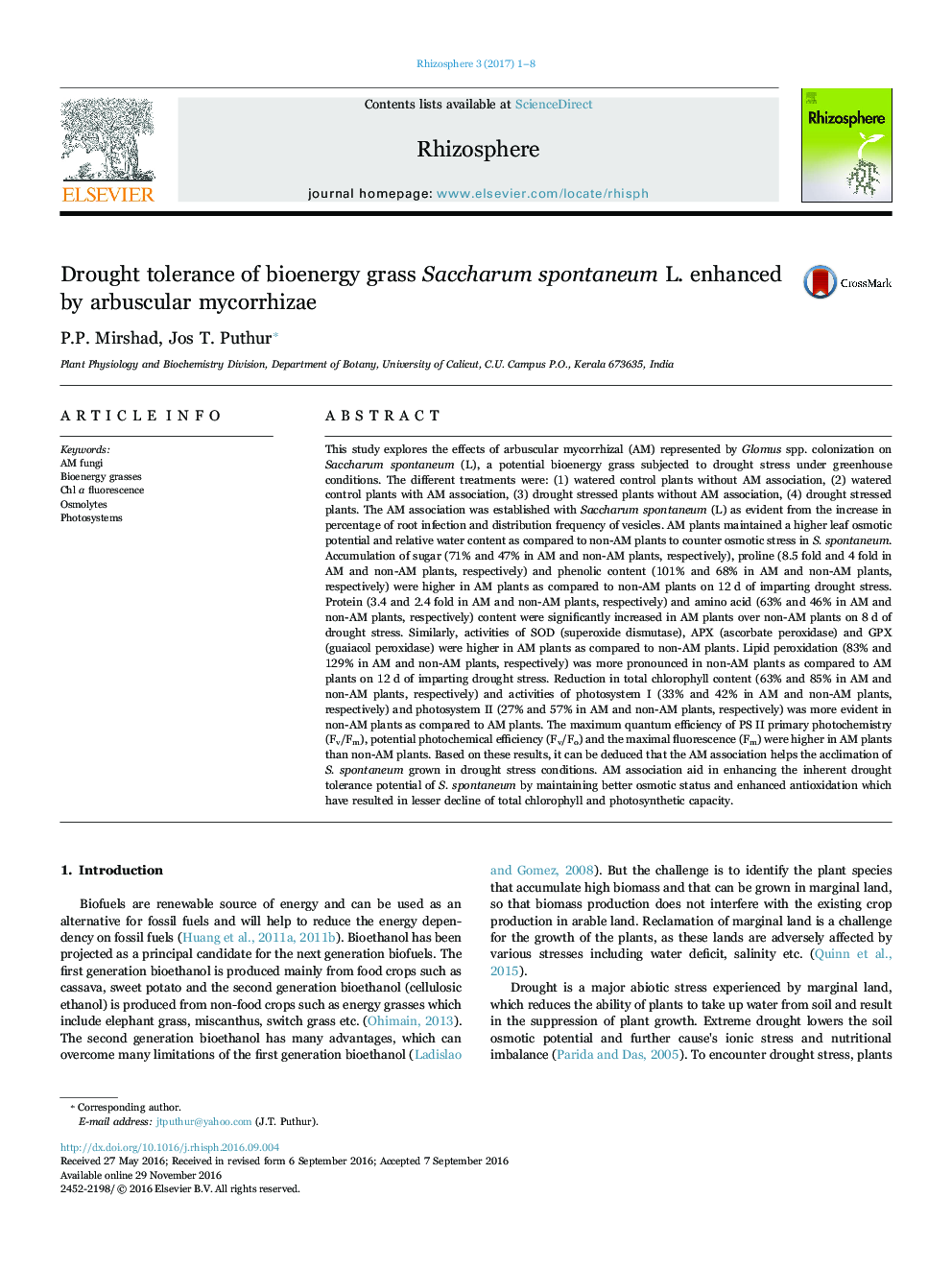| کد مقاله | کد نشریه | سال انتشار | مقاله انگلیسی | نسخه تمام متن |
|---|---|---|---|---|
| 5762845 | 1412951 | 2017 | 8 صفحه PDF | دانلود رایگان |
عنوان انگلیسی مقاله ISI
Drought tolerance of bioenergy grass Saccharum spontaneum L. enhanced by arbuscular mycorrhizae
دانلود مقاله + سفارش ترجمه
دانلود مقاله ISI انگلیسی
رایگان برای ایرانیان
کلمات کلیدی
موضوعات مرتبط
علوم زیستی و بیوفناوری
علوم کشاورزی و بیولوژیک
علوم زراعت و اصلاح نباتات
پیش نمایش صفحه اول مقاله

چکیده انگلیسی
This study explores the effects of arbuscular mycorrhizal (AM) represented by Glomus spp. colonization on Saccharum spontaneum (L), a potential bioenergy grass subjected to drought stress under greenhouse conditions. The different treatments were: (1) watered control plants without AM association, (2) watered control plants with AM association, (3) drought stressed plants without AM association, (4) drought stressed plants. The AM association was established with Saccharum spontaneum (L) as evident from the increase in percentage of root infection and distribution frequency of vesicles. AM plants maintained a higher leaf osmotic potential and relative water content as compared to non-AM plants to counter osmotic stress in S. spontaneum. Accumulation of sugar (71% and 47% in AM and non-AM plants, respectively), proline (8.5 fold and 4 fold in AM and non-AM plants, respectively) and phenolic content (101% and 68% in AM and non-AM plants, respectively) were higher in AM plants as compared to non-AM plants on 12Â d of imparting drought stress. Protein (3.4 and 2.4 fold in AM and non-AM plants, respectively) and amino acid (63% and 46% in AM and non-AM plants, respectively) content were significantly increased in AM plants over non-AM plants on 8Â d of drought stress. Similarly, activities of SOD (superoxide dismutase), APX (ascorbate peroxidase) and GPX (guaiacol peroxidase) were higher in AM plants as compared to non-AM plants. Lipid peroxidation (83% and 129% in AM and non-AM plants, respectively) was more pronounced in non-AM plants as compared to AM plants on 12Â d of imparting drought stress. Reduction in total chlorophyll content (63% and 85% in AM and non-AM plants, respectively) and activities of photosystem I (33% and 42% in AM and non-AM plants, respectively) and photosystem II (27% and 57% in AM and non-AM plants, respectively) was more evident in non-AM plants as compared to AM plants. The maximum quantum efficiency of PS II primary photochemistry (Fv/Fm), potential photochemical efficiency (Fv/Fo) and the maximal fluorescence (Fm) were higher in AM plants than non-AM plants. Based on these results, it can be deduced that the AM association helps the acclimation of S. spontaneum grown in drought stress conditions. AM association aid in enhancing the inherent drought tolerance potential of S. spontaneum by maintaining better osmotic status and enhanced antioxidation which have resulted in lesser decline of total chlorophyll and photosynthetic capacity.
ناشر
Database: Elsevier - ScienceDirect (ساینس دایرکت)
Journal: Rhizosphere - Volume 3, Part 1, June 2017, Pages 1-8
Journal: Rhizosphere - Volume 3, Part 1, June 2017, Pages 1-8
نویسندگان
P.P. Mirshad, Jos T. Puthur,